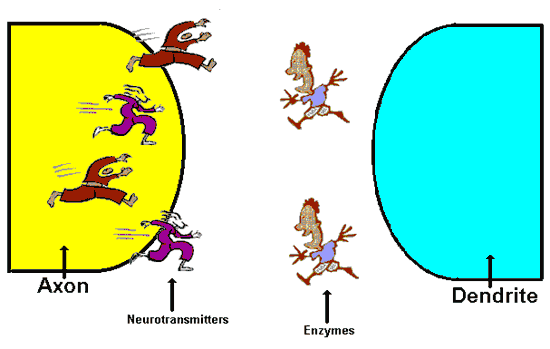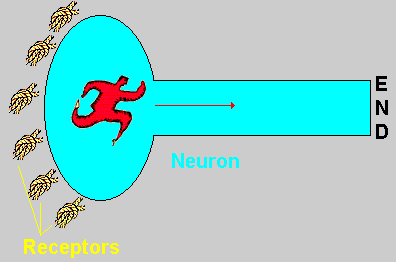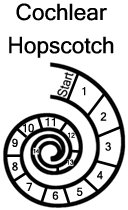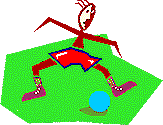Neuroscience For Kids
 These games are best played outside or inside where there is a lot of
space to run around.
These games are best played outside or inside where there is a lot of
space to run around.
Synaptic Tag
Before starting, you might want to read about the synapse.
In the game of "synaptic tag," you are part of the synapse. The object of the game is to get as many neurotransmitters across the synapse to the dendrite without being caught (deactivated) by the enzyme. It is like a game of tag. Draw or find a space for the axon and a dendrite (see the picture below). Some players are neurotransmitters and they wait in the axon; other players are enzymes, they wait in the gap between the axon and the dendrite. It is best to have more neurotransmitters than enzymes. The enzymes are "it."
When someone says "go," the neurotransmitters run across the synapse as fast as possible without being touched by an enzyme. If a neurotransmitter is touched by an enzyme, it must go back (be reabsorbed) into the axon and wait until the next turn. If a player makes it to the dendrite, the player is safe. Play as many times as you like. Make sure everyone has a chance to be a neurotransmitter and an enzyme. Note: make sure you provide enough space in the axon (synaptic terminal) so players will not run into one another.
Complete Lesson Plan for Synaptic Tag
Set-up for Synaptic Tag

Neuron Chain
If you liked "Synaptic Tag," you will like "Neuron Chain." Neuron Chain is another game of tag. Start with just one player who is "it." This player is the first neuron and tries to tag another player. A tagged player must hold the hand of the first player and together they have to chase the other players. As more and more players are tagged, they are added to the chain of neurons. The game ends when all the players are part of the chain.
Complete Lesson Plan for Neuron Chain
Neuron Chain

All or None
As you may know, an action potential is an "all or none" event. When a neuron receives messages from other neurons, it changes its resting membrane potential. If the neuron is "depolarized" enough to reach threshold, it will fire a full-sized action potential. If it does not reach this threshold, it will not fire an action potential. Therefore, it is ALL OR NONE.
Try this race to model this all or none action potential. Have two or more teams. Each player (except one on each team) is a neurotransmitter in the synaptic cleft. One player on each team stays ready inside of a neuron - this player will be the action potential. When someone says "go," the neurotransmitters run toward the neuron. At the neuron, there are ropes with a knot in each one. The rope represents a receptor for the neurotransmitter. One rope for each player. The players must undo the knot in their rope. When they get the knot untied, they must put the rope inside of the neuron. When all the ropes are untied and placed in the neuron, the player who was waiting inside of the neuron runs down the neuron, down the axon, to the end. This represents the firing of the action potential. The action potential cannot start until ALL of the ropes are untied and placed inside of the neuron. The team that gets their action potential to the end of the neuron first is the winner.
So in this game:
- Players in synaptic cleft = neurotransmitters
- Player in neuron = action potential
- Ropes = receptors
- Untying rope = receptor binding
- Putting ropes inside neuron = depolarization of neuron
- Running down the neuron = the "All or None" action potential
All or None Game
Brain-Freeze Tag
Brain-freeze tag is similar to the game of "freeze tag" with a few different rules. Start with one player who is "it." This player then tries to tag another player. A tagged player must freeze (hold still). The only way for the player to get unfrozen is to have another player touch his or her hand AND say a neuroscience word. After the word is said, both players are back in the game and must avoid the "it" player.
To make the game harder, you can make a rule that the same neuroscience word cannot be used during a single game. Another rule you could make is that the words have to be part of the brain (neuroanatomy tag) or the words have to be neurotransmitters (neurochemistry tag).
Complete Lesson Plan for Brain Freeze Tag
Neuron Jump Rope
 Here is a simple
counting game played with a jump rope. Start out by jumping rope at a
normal speed and say the following rhyme:
Here is a simple
counting game played with a jump rope. Start out by jumping rope at a
normal speed and say the following rhyme:
Neuron, neuron in my brain,
How many neurons will I gain?
After you say the rhyme, jump rope as fast as you can. Count the number of times you jump without missing. That's the number of neurons you get. See who can get the most neurons. See if you can get to 100,000,000,000 (the number of neurons in the human brain) without missing! How long do you think it would take to get to 100,000,000,000 jumps if you jumped at a rate of one every second?
Cochlear Hopscotch
 Using chalk, draw a pattern similar to the one on the right. The pattern
is similar to the cochlea in your ear. The
object of hopscotch is to hop over a marker (a rock, bean bag, stick or
coin) to the next space without making a mistake.
Using chalk, draw a pattern similar to the one on the right. The pattern
is similar to the cochlea in your ear. The
object of hopscotch is to hop over a marker (a rock, bean bag, stick or
coin) to the next space without making a mistake.
The first player tosses a marker into square 1. The player must then hop over square 1 on to square 2, then square 3, 4, and so on. At the last square, the player must turn around and hop back. When the player gets to square 2, the player must pick up the marker, hop on square 1 and then go back to start. If the player loses balance, lands on two feet, or hops onto a line, it ends a turn. If successful, the player tosses the marker into square 2 and repeats the hopping sequence. This is repeated for all of the squares. If the marker does not land in the appropriate square, then the players turn is over.
Balance Race
Use your brain as you balance objects during this race. Mark start and finish lines about 100 meters apart. Each racer is then given a plate with a small ball (a tennis ball works well) on it. At "GO!" the racers must run to the finish line. If the ball falls off of the plate before reaching the finish line, then the racer must go back to the start line before getting back into the race.
Think about other objects that racers must balance.
Marco Polo
 Marco Polo is a game
that uses the ability to localize sound. The game is often played in the
swimming pool, but you can play it outside too. One person is "IT." The
other players must stay in the pool or within an outlined space (like a
basketball court). The object of the game is for "IT" to tag any other
player; the catch is that "IT" must keep his or her eyes CLOSED. To help
find other players, "IT" can say, "Marco." The other players must respond
with the word "POLO." Using this sound, "IT" tries to tag someone. A
person who is tagged becomes the new "IT."
Marco Polo is a game
that uses the ability to localize sound. The game is often played in the
swimming pool, but you can play it outside too. One person is "IT." The
other players must stay in the pool or within an outlined space (like a
basketball court). The object of the game is for "IT" to tag any other
player; the catch is that "IT" must keep his or her eyes CLOSED. To help
find other players, "IT" can say, "Marco." The other players must respond
with the word "POLO." Using this sound, "IT" tries to tag someone. A
person who is tagged becomes the new "IT."
Saltatory Conduction - Have a Ball!
 Saltatory conduction is the way that an
action potential travels down a myelinated nerve
fiber. The action potential "jumps" from node to node thereby increasing
the speed of transmission.
Saltatory conduction is the way that an
action potential travels down a myelinated nerve
fiber. The action potential "jumps" from node to node thereby increasing
the speed of transmission.
To model saltatory conduction (and to have a bit of competition), divide players into two equal teams. Each team should line up with players behind each other and separated by about 2-3 feet. Each player represents a "node of Ranvier" along a myelinated nerve fiber. The first player (the first "node") is given a ball. The ball represents the action potential.
When someone says "GO!," the first player must bend over and pass the ball through his or her legs to the next player. This next player must keep the ball moving by hitting the ball to pass it to the next player in line. The ball should travel through the legs of all players until it gets to the last player.
In this way, the ball (the "action potential") will jump from person to person ("node to node") as it makes its way down the line of players (the "nerve fiber").
Copyright © 1996-2020, Eric H. Chudler, University of Washington
